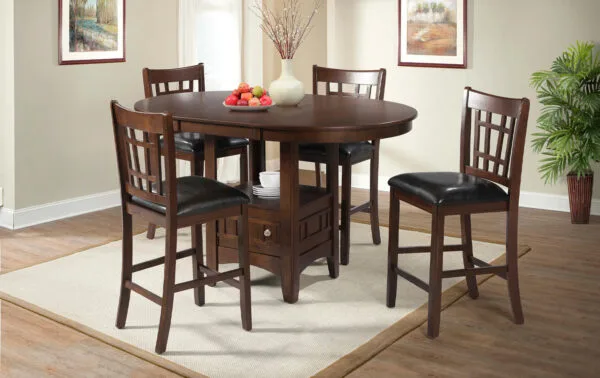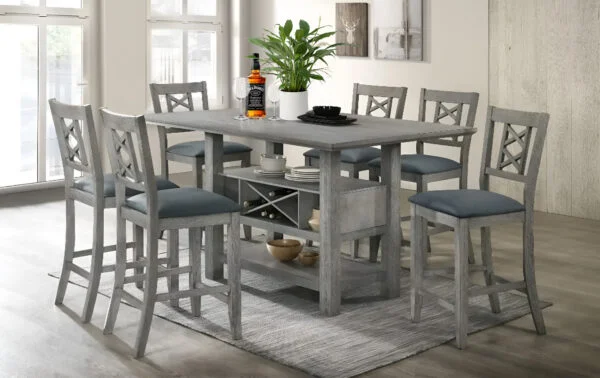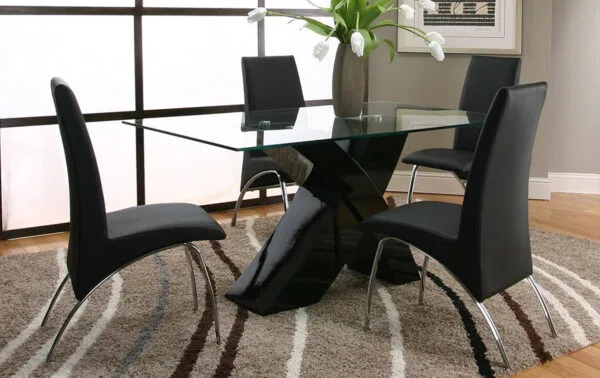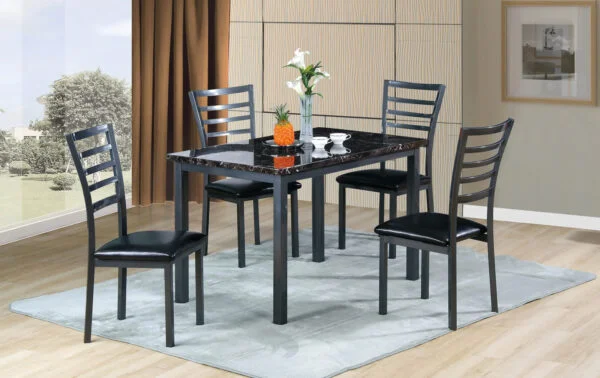Dining Table Material Guide: What Works Best for Your Lifestyle?
Choosing the right dining table material is about more than just style; it’s about finding a match for your daily routine, space, and maintenance preferences. Whether you host frequent dinner parties, have young kids, or prefer low-maintenance living, the material you choose plays a big role in durability, upkeep, and overall feel. From classic wood and sleek glass to luxurious marble and budget-friendly alternatives, each option offers unique benefits. In this guide, we’ll break down the most popular dining table materials to help you weigh the aesthetic appeal and functional benefits against your lifestyle and household needs.
Solid Wood Dining Table Material
Let’s start with the most robust option: solid wood. This natural dining table material not only has a distinct organic charm but also boasts exceptional strength and durability. One of the most compelling aspects of solid wood dining tables is the uniqueness of each piece; the distinct grain patterns, knots, and variations ensure that no two tables are alike. This individuality makes them timeless, offering both functionality and aesthetic appeal that can endure for generations. With proper care, solid wood tables develop a warm patina over time, becoming even more beautiful as they age.
When considering options, think about Oak, Acacia, and Teak for their hardness and density. They are ideal for everyday use while providing a lovely rustic ambiance. Walnut is another great option, with its luxurious smoothness and rich tones, it adds an air of sophistication. Meanwhile, Mango brings a touch of sustainability and warmth with its golden-brown hues adorned with unique streaks.
Is Solid Wood the Right Choice for You?
Deciding whether to invest in a solid wood dining table depends on your personal preferences and living situation. If you value unique heirloom pieces that can last a lifetime, a solid wood table could be the perfect centerpiece for your dining area. This material shines in vintage-inspired homes, cottages, modern farmhouses, or rustic interiors; essentially, it complements a timeless, “forever home” beautifully.
Additionally, solid wood is a fantastic choice for families, as it can withstand the daily wear and tear from busy hands, spills, and multifunctional use. However, if you frequently update your decor, solid wood may not be the ideal fit. The investment is substantial, not only due to its striking beauty but also its durability and prestige. This is something to consider if you’re working with a tight budget. Moreover, for those who rent or often move, think carefully, as solid wood furniture can be cumbersome to transport.
Engineered Wood
Engineered wood has emerged as a leading material choice for dining tables, mostly for its affordability with sustainability. This innovative material mirrors the aesthetic and structural qualities of solid wood furniture but is crafted from man-made components: wood fibers, particles, or veneers intricately bonded together.
MDF, or medium-density fiberboard, is the most popular option, crafted from fine wood fibers compressed into a dense, smooth panel. Then we have particleboard, which uses larger wood chips or sawdust pressed together. While it’s a budget-friendly option, it offers less density compared to MDF. Another option is plywood, consisting of layers of wood veneers glued in alternating grain directions. It has enhanced strength but comes at a much lower cost.
What makes engineered dining table material particularly appealing is its sustainable nature. In today’s eco-conscious world, consumers prioritize materials that minimize environmental impact, and engineered wood is a smart solution that doesn’t require the felling of entire trees.
Is an Engineered Wood Dining Table Right for You?
If you’re on the lookout for budget-friendly dining room furniture, an engineered wood table might just be your perfect match. You can achieve the look of elegant hardwood tables without the hefty price tag. MDF and veneered options not only offer affordability but also a wealth of customization possibilities. From oak and walnut finishes to high-gloss and matte surfaces, they are available in a range of colors and textures.
Affordability is a significant advantage, so if you’re a budget-conscious consumer or someone who’s furnishing their first home, this option might be for you. Their lightweight nature also makes them easy to move and replace, ideal for renters or homeowners who switch decor frequently.
However, it’s essential to consider whether this engineered dining table material will meet your long-term needs. If you’re seeking a table that will endure for decades or if you have young children or a high-traffic household, you may want to explore more durable options.
Laminate Dining Table Material
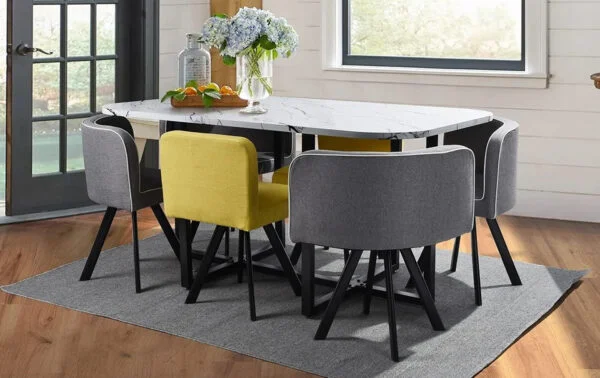
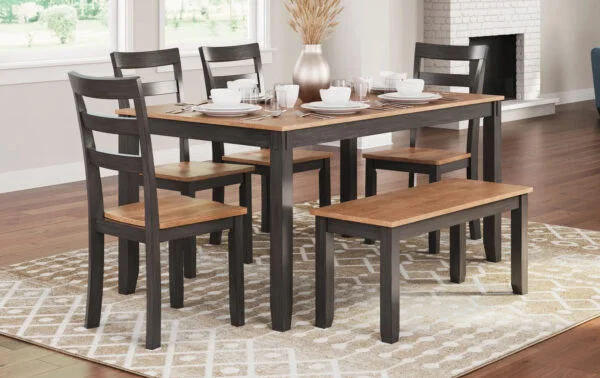
Laminate is a highly popular, budget-friendly dining table material choice. This synthetic material is created by bonding layers of plastic resin, typically melamine, onto the table base. Imagine it as a decorative surface designed to replicate the look of wood, stone, or vibrant colors, all sealed with a protective coating for added durability.
What sets laminate dining tables apart is their exceptional resilience for daily use. They provide a cost-effective, low-maintenance alternative to both solid and engineered wood tables, as well as stone options. The manufacturing process involves printing a realistic design layer that mimics various materials. A layer of protective melamine resin coat is usually applied to enhance durability. The result is a table that not only looks fantastic but is also incredibly easy to care for. What’s better? It’s available in a vast array of styles, from natural wood grains to bold solid colors.
Is Laminate the Right Choice for You?
Want the realistic charm of natural dining table materials without the hefty price tag? Laminate could be the ideal choice for you. While laminate is undoubtedly affordable, it surpasses wood veneer in terms of durability. It is ideal for busy households bustling with kids and pets. High-quality laminate tables are impressively resistant to spills, stains, and scratches, sparing you the stress of everyday messes. Besides, cleaning is also a breeze; just a quick wipe, and you’re done.
With a price point that’s easy on the wallet, laminate tables are perfect for starter homes. They are especially suitable for young professionals or first-time homeowners, providing a lightweight and chic solution for temporary living arrangements. However, it’s important to recognize that laminate dining table material isn’t for everyone. If you’re seeking an authentic texture and feel in wood or marble, laminate may not meet your expectations. Additionally, if you have heavy usage needs, it may be wise to consider other options.
Tempered Glass
Tempered glass is another coveted material for dining tables, especially when combined with other materials like wood or metal. So, what exactly sets tempered glass apart, and why is it favored in furniture, particularly for something as essential as a dining table? Tempered glass is a type of safety glass that undergoes a heat treatment, making it up to five times stronger than regular glass. The creation process involves heating ordinary glass to elevated temperatures and then quickly cooling it down. This method enhances the glass’s resistance to impact while significantly improving its resilience.
Additionally, tempered glass boasts greater resistance to heat and pressure, making it an excellent choice as a dining table material. One of the standout features of tempered glass is its visual lightness. Unlike opaque materials, glass allows unobstructed sightlines, which can open up a space and create a sense of airiness.
Is Glass the Right Choice for You?
While tempered glass offers undeniable benefits, this dining table material might not suit everyone’s needs. Their appeal tends to resonate more with individuals who have open-concept apartments, tight dining rooms, or cozy combined spaces. The transparent nature of tempered glass enables light to flow freely, instantly enhancing the feeling of space.
Furthermore, tempered glass tables appeal to those who appreciate a contemporary touch in their decor. The clean surface works well in minimalist settings while also making a bold statement in more formal or upscale environments. For hosts and frequent entertainers, these tables serve as a stunning backdrop, allowing centerpieces, lighting, and tableware to truly shine.
However, it’s important to consider that glass may not be the best fit for households with young children. Its hard surface poses a risk for accidental bumps and bruises. Additionally, tempered glass is prone to showing fingerprints, smudges, and any crumbs or streaks, necessitating regular upkeep. For those with busy lifestyles, this aspect may pose an inconvenience.
Marble and Faux Marble
Marble, whether natural or faux, is known for its luxurious appeal. Normally, you won’t find a dining table made entirely of marble; it is generally used as a tabletop. Natural marble is a metamorphic stone that forms from limestone subjected to immense pressure and heat over time. Its primary composition is calcite, beautifully characterized by unique veins and swirls that arise from mineral impurities. This individuality makes each marble slab distinct, making it one of the highly prestigious dining table materials.
On the other hand, faux marble is made using various methods like laminate layers, printed MDF, resin composites, or marble-look quartz and sintered stone. It serves as an affordable alternative to the costly organic varieties. Both natural and engineered marble tables exude a sense of opulence, enhanced by the variations in veining and color.
Is a Marble Dining Table Material Right for You?
If you love the drama and beauty of high-end decor, marble could be your dream dining table material. It makes a bold statement for those who are style-conscious and want to create a high-end formal dining atmosphere. Marble complements various dining styles, including contemporary classic, luxury minimalism, and European elegance, to name a few.
If you’re furnishing a dining room meant for occasional entertaining, a marble table could be ideal. However, if you adore the luxurious vibe of marble but need something more practical, faux marble may be better. These alternatives not only offer a more budget-friendly option, but they also simplify your life. With faux marble, you can put aside worries about spills or heat marks, excellent for households with kids or teens. In addition, faux marble’s lighter weight makes it incredibly portable, making it great for temporary spaces or renting.
Metal Dining Table Material
Metal is increasingly favored as a material for dining tables, often complementing other elements rather than standing alone. This material has become a staple for frames, especially when paired with elegant glass tops that exude a contemporary charm. Wooden surfaces are a common pairing with metallic frames. This pairing adds a touch of warmth and creates a captivating contrast. Another striking combination is stone tops, such as marble or granite, adding luxurious flair to the dining area.
Moreover, metal has impressive strength, making this dining table material perfect for supporting heavy surfaces like stone or thick hardwood. Additionally, it is resistant to warping or expanding due to humidity and temperature changes, ensuring long-lasting stability. Not to mention, metal surfaces come in a variety of finishes, matte black, brushed nickel, brass, chrome, bronze, and powder-coated colors, offering style versatility for any home décor.
Is a Metal the Right Choice for You?
If you appreciate modern design combined with practical durability, metal is worth considering. Its practical benefits, including remarkable endurance, stability, and longevity, make it perfect for daily use. You can rest easy knowing that these tables hold up exceptionally well to heavy and repeated use, which is particularly beneficial for households with children or pets.
To create a lasting centerpiece in your dining room, consider pairing a metal frame with a durable solid wood top or resilient stones like quartz. These combinations guarantee a long lifespan for the furniture.
Moreover, metal is a favorite among home decorators. It provides endless design possibilities for those who love to experiment with contrasts and mixed materials. A metal dining table can easily shift between a modern, minimalistic vibe with a glass top to a warm and rustic aesthetic with wood or a luxe feel with marble. However, if your heart leans toward a cozy, traditional, or antique looks, metal may not be ideal for your vision.


